AN-0972: How the AD7329 Helps Reduce Costs
Introduction
The AD7329 is an 8-channel, 12-bit plus one additional sign bit, bipolar input ADC. The part has four software selectable input ranges: ±4 × VREF, ±2 × VREF, ±VREF, and 0 to 4 × VREF. Each analog input channel can be independently programmed to one of the four analog input ranges. The AD7329 is manufactured using the industrial CMOS (iCMOS®) process, which allows the ADC to accept large bipolar analog input signals while providing increased performance, reduced power consumption, and reduced package size compared with other bipolar ADC solutions available today.
The AD7329 boasts a very flexible design, which allows the ADC to be configured to suit a wide variety of application requirements. This application note outlines how to achieve a very high input impedance from the AD7329 while retaining the ability to accept large bipolar analog input signals. It also discusses how the AD7329 can be configured to accommodate small input signals while still maintaining high levels of performance.
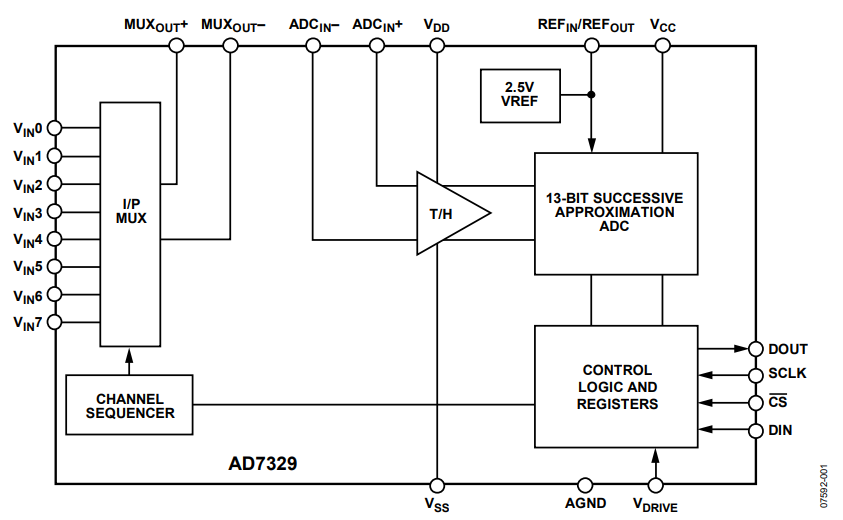
Figure 1. AD7329 Functional Block Diagram.
AD7329 Analog Inputs
The AD7329 analog inputs can be configured as eight single-ended inputs, four true differential input pairs, seven pseudo differential inputs, or four pseudo differential input pairs.
The AD732x family of ADCs is designed using the iCMOS process and can accept true bipolar analog input signals. Some bipolar input ADCs use a resistive structure on the analog inputs to scale and level shift the bipolar signal into a voltage range required by the internal ADC. The disadvantage of these resistive analog input ADCs is that the source driving these analog inputs realizes very low source impedance and, thus, a larger input current is required to drive these inputs.
The equivalent analog input structure of the AD7329 is shown in Figure 2. The AD7329 samples the bipolar analog input signal directly on the ADC sampling capacitor and, therefore, less current is required to drive the AD7329 input structure than the resistive input ADCs.
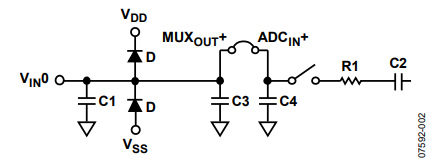
Figure 2. AD7329 Analog Input Structure—Single-Ended Mode.
The analog input channels on the AD7329 are routed through an on-chip multiplexer. The outputs of this multiplexer are routed out to the MUXOUT+ and MUXOUT− pins. The AD7329 also features the ADCIN+ and ADCIN− pins. The ADCIN+ and ADCIN− pins provide access to the AD7329 track-and-hold circuit and the sampling capacitor of the ADC.
When the MUXOUT+ pin connects directly to the ADCIN+ pin, the AD7329 operates like many other ADCs. The input signal is sampled directly to the sampling capacitor. The source driving the AD7329 in this configuration needs to provide the current required to drive the ADC input, and settle to the required accuracy within the acquisition time of the ADC (300 ns).
Figure 3 shows the current required to drive the AD7329 analog inputs when the MUXOUT+pin is shorted to the ADCIN+ pin. The plot shows that as the sampling rate increases, the current required to drive the analog inputs increases as well.
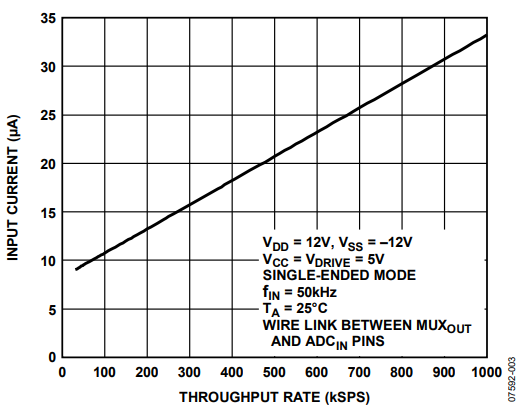
Figure 3. Input Current vs. Throughput Rate with Wire Link Between MUXOUT and ADCIN Pins.
As with all SAR converters when the internal track-and-hold switch goes from hold to track, there is a transient kick back from the ADC. The source driving the AD7329 must be able to recover from this transient and settle to the required accuracy within the acquisition time of the ADC. For applications operating at the maximum sampling frequency, it may be necessary to use an input buffer amplifier to drive the ADC and isolate the source from the ADC track-and-hold switch.
The flexible design on the AD7329 allows an op amp to be placed between the MUXOUT and ADCIN pins. In this configuration, the AD7329 boasts very high analog input impedance and the op amp also functions to isolate the source from the AD7329 input structure.
The op amp used in this configuration must be capable of accepting bipolar signals up to ±10 V. The signals from the MUXOUT pins are still high voltage bipolar signals. In Figure 4, the AD8021 low noise high speed amplifier is used. The AD8021 can accommodate the large bipolar analog input signals while still being able to settle within the required acquisition time of the ADC.
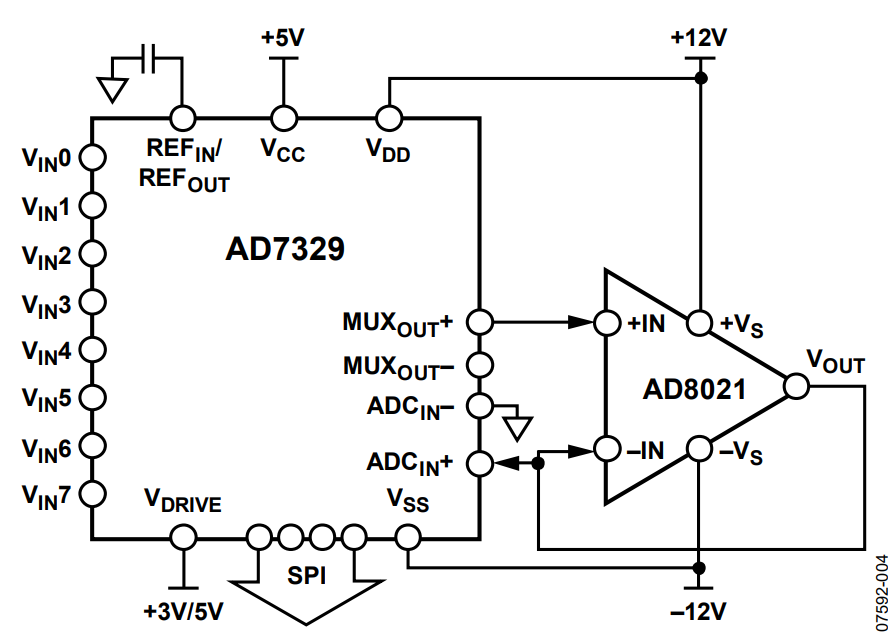
Figure 4. Buffer Between MUXOUT and ADCIN Configuration for AD7329.
The input impedance that the source driving the AD7329 sees is now the input impedance of the AD8021. In this configuration, the current required by the source to drive the AD7329 is <0.2 μA with the AD8021 placed between the MUXOUT and ADCIN pins.
Figure 5 shows the current required to drive the AD7329 using the configuration outlined in Figure 4. This input current vs. throughput rate plot was generated during conversions on a single channel
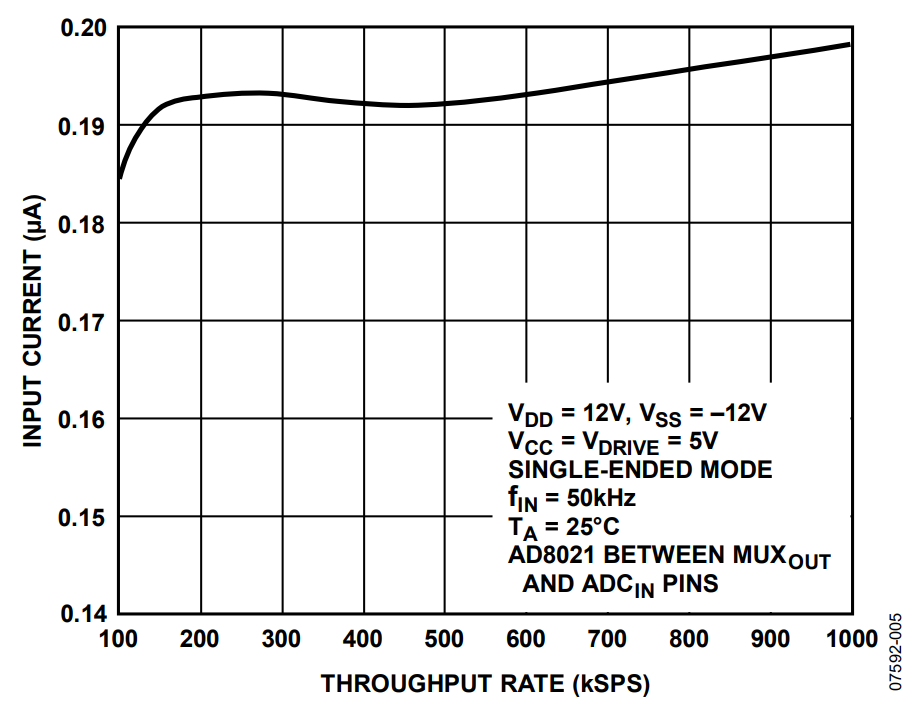
Figure 5. Input Current vs. Throughput Rate with AD8021 Connected Between MUXOUT and ADCIN Pins.
This configuration has the advantage that at the maximum sampling frequencies a single op amp can be used for eight analog input channels. The analog input impedance of the AD7329, as seen by the source, is in the MΩ region and very little current is required to drive the eight analog input pins. The op amp between the MUXOUT and ADCIN pins isolates the source from the switching nature of the ADC input. This configuration reduces component count, board area, and board cost.
Depending on the application requirements, analog input voltages, supply voltage, and sampling frequencies, other bipolar input op amps can be used between the MUXOUT and ADCIN pins on the AD7329.
Bipolar Analog Input Signals
The analog input channels on the AD7329 can be independently programmed to accept one of four input signals. The AD7329 can accept input signals of ±4 × VREF, ±2 × VREF, ±VREF, and 0 to 4 × VREF. Using the internal 2.5 V reference, these input ranges translate to be ±10 V, ±5 V , ±2.5 V, and 0 V to +10 V. The AD7329 also allows for an external reference voltage to be applied to the REFIN/REFOUT pin. The specified voltage input range on the reference voltage is from 2.5 V to 3 V. With a 3 V external reference, the AD7329 can accept input signals of ±12 V, ±6 V, ±3 V, and 0 V to +12 V. In differential input mode, the AD7329 can accept input signals of ±24 V, ±12 V, ±6 V and 0 V to +24 V differential with a 3 V external reference, depending on which range was selected. When increasing the AD7329 reference input voltage and, thus, the analog input voltages, the buffer op amp between the MUXOUT and ADCIN pins needs to be able to accommodate these larger bipolar input signals.
When increasing the analog input voltages on the AD7329 the VDD and VSS supply voltages should be equal to or greater than the maximum analog input voltage applied to the ADC. At the maximum sampling frequency, as the VDD and VSS supplies are reduced, the THD performance of the AD7329 degrades (see Figure 6). Therefore, the VDD and VSS supply voltages used in an application depend on the THD performance the application requires. As the VDD and VSS supplies are reduced, the on resistance (RON) of the input multiplexer and the track-and-hold switch increase. To meet the specified performance when using the minimum VDD and VSS supplies for the analog input ranges, the overall sampling rate of the AD7329 should be reduced. This allows more settling time for the ADC to compensate for this increase RON of the input multiplexer.
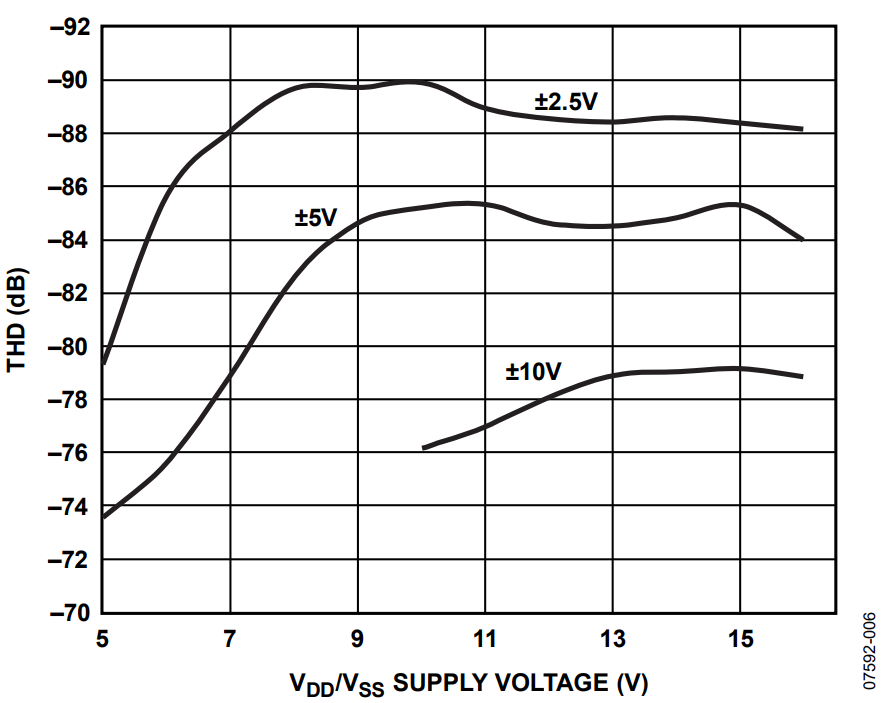
Figure 6. THD vs. Power Supply Voltage.
In addition to converting larger bipolar analog input signals, the AD7329 can also be configured to accommodate signals in the millivolt range. By placing gain around the op amp, configured as in Figure 7, the AD7329 can convert small signals in the millivolt range.
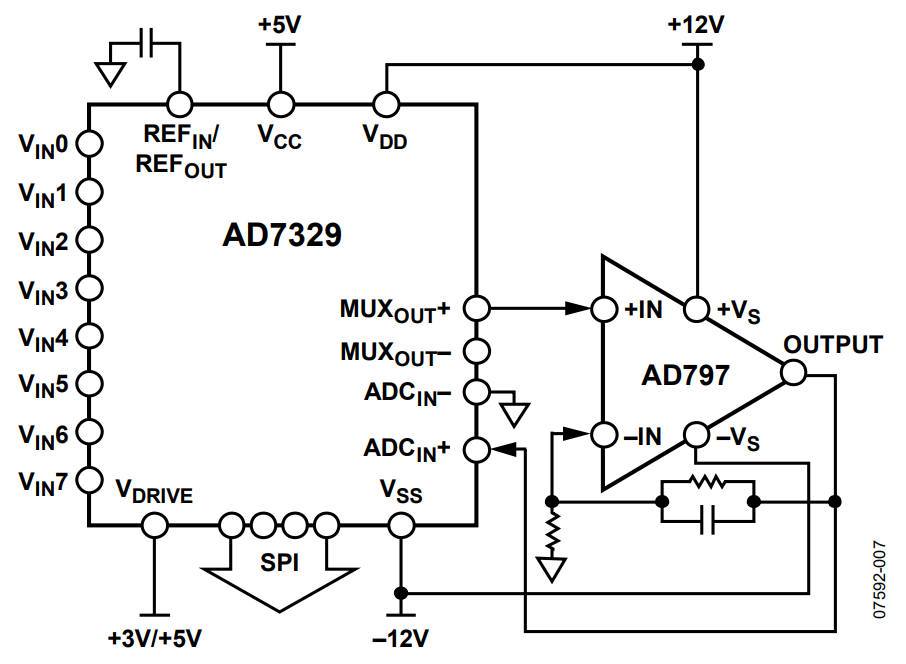
Figure 7. Gain Stage Between MUXOUT and ADCIN Configuration for AD7329.
Using the configuration shown in Figure 7, small signals in the mV range can be applied to the analog inputs; these signals are then gained up through the AD797 device. The gained up signal is then applied to the ADCIN pin, which in turn connects to the internal sampling capacitor through the track-and-hold switch.
The gain on the AD797 can be chosen to ensure that the signal applied to the ADCIN pins uses the full dynamic range of the ADC. This, in turn, yields better results from the AD7329.
Table 1 shows that the performance achieved on the ±10 V range at 1 MSPS while varying the gain on the AD797 op amp between the MUXOUT and ADCIN pins using single-ended mode and 10 kHz input tone.
| Gain (V/V) | SNR (dB) | THD (dB) | ENOB (bits) |
| 1 | 73.57 | −80.80 | 11.93 |
| 20 | 73.00 | −79.91 | 11.83 |
| 50 | 72.34 | −79.90 | 11.72 |
| 100 | 72.28 | −79.81 | 11.71 |
| 200 | 71.66 | −78.99 | 11.61 |
| 500 | 71.48 | −78.46 | 11.58 |
| 1000 | 69.94 | −75.38 | 11.32 |
As the gain increases, degradation in SNR and THD becomes noticeable. Using the AD7329, configured as in Figure 7 for gain of 1000, the converter can still achieve greater than 11 effective number of bits (ENOB). Using this value of gain stage between MUXOUT and ADCIN pins, the AD7329 achieves a very wide dynamic range equivalent to a 21-bit ADC.
In some applications, it may be necessary to change the gain for varying the amplitude of the signals for different input channels (see Figure 8). In this case, a multiplexer can be used in the AD797 feedback path, allowing different resister values to be switched in to change the gain settings. The AD797 and the ADG412 are recommended parts, for designing programmable gain amplifiers (PGAs). Figure 9 shows the proposed schematic for PGA applications.
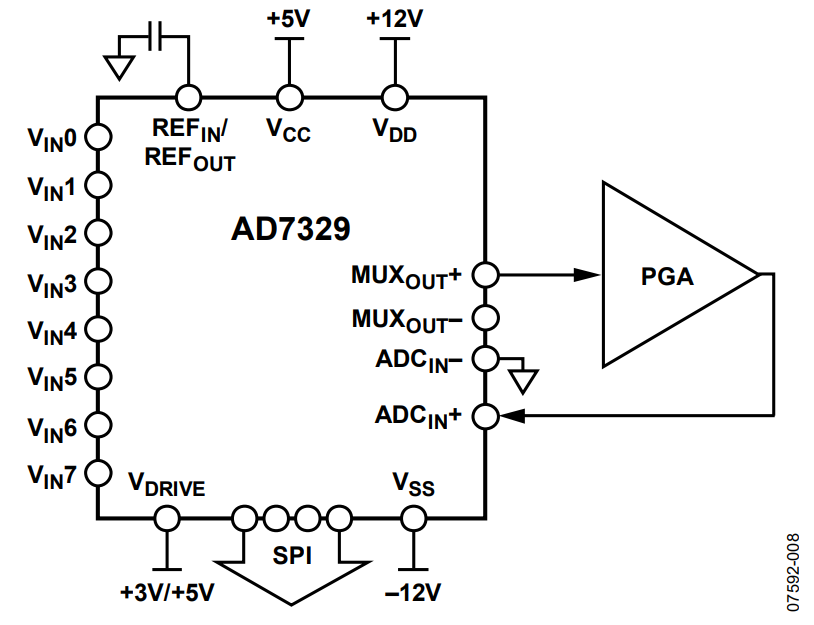
Figure 8. Programmable Gain Amplifier Between MUXOUT and ADCIN Configuration for AD7329.
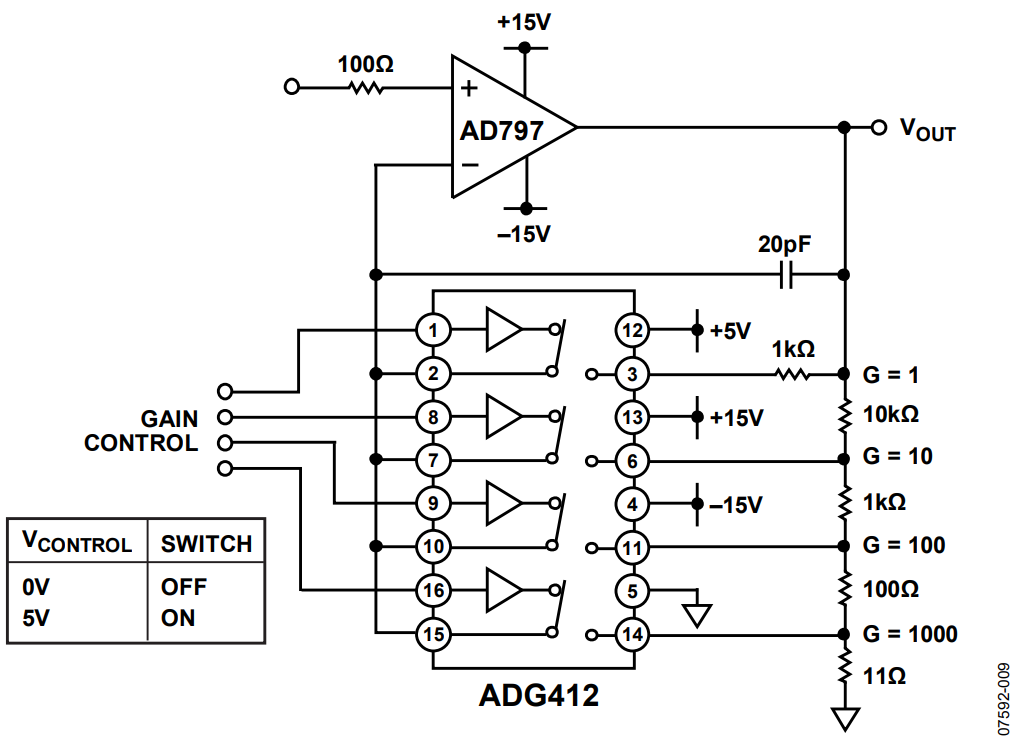
Figure 9. A Very Low Noise PGA Using the AD797 and the ADG412.
Conclusion
The AD7329 is a versatile device. Significant cost savings can be realized for the bill of materials in a data acquisition system. Only one amplifier is used to provide the high input impedance required for eight analog input channels, thereby saving the cost of seven amplifiers. Data acquisition systems utilizing the AD7329 can interface to sensors/transducers with dynamic ranges that can vary from the millivolt range up to ±12 V. This ability is due to the addition of a programmable gain amplifier.

